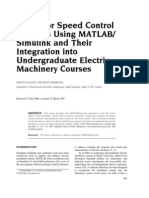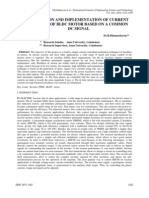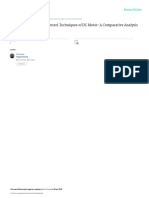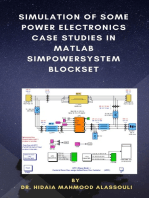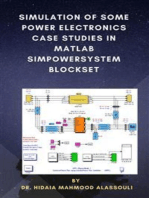Basic Tutorial On Sliding Mode Control I
Uploaded by
mukhlisBasic Tutorial On Sliding Mode Control I
Uploaded by
mukhlisBasic Tutorial on Sliding Mode Control
in Speed Control of DC-motor
1st Hari Maghfiroh 2nd A. Sujono
Dept. Electrical Engineering Dept. Electrical Engineering
Universitas Sebelas Maret Universitas Sebelas Maret
Surakarta, Indonesia Surakarta, Indonesia
hari.maghfiroh@gmail.com agus.sjn.te16@gmail.com
3rd Musyaffa' Ahmad 4th Chico Hermanu Brillianto Apribowo
Dept. Electrical Engineering Dept. Electrical Engineering
Universitas Sebelas Maret Universitas Sebelas Maret
Surakarta, Indonesia Surakarta, Indonesia
mus_ahmad@student.uns.ac.id chico@ft.uns.ac.id
Abstract – One technology to support production speed is electric needed. In this research, the SMC method will be applied in
motors with high performance, efficiency, dynamic speed and good speed control of DC motor. Classical PID is used to compare
speed responses. DC motors are one type of electric motor which is the performance of SMC.
used in the industry. Sliding Mode Control (SMC) is the robust non- This paper is organized as follows. Section II present the
linear control. The basic theory regarding SMC is presented. The theoretical review of SMC which mentioned before. In section
SMC design which is implemented is the speed control of the DC
III, design of SMC for speed control of DC motor is presented.
motor is analyzed. The controller is implemented in simulation using
MATLAB / Simulink environment. The step response and signal
In section IV, the simulation results are discussed. Finally, the
tracking test unit are carried out. The results show that SMC has a conclusion is in section V.
better performance compare to PID which is faster settling time and
II. SLIDING MODE CONTROL
no overshoot and undershoot.
The SMC works by bringing the state from the system to the
Keywords—railway, traction motor, motor control, MRAS sliding surface and then to the central point, as illustrated in
Figure 1 (a). Next Figure 1 (b) shows the switching of the
I. INTRODUCTION control signal tracking the sliding surface to the origin. Sliding
One of the technologies used to accelerate the production surface is a condition where the switching function (s) is zero
process in the industry is an electric motor. Electric motor based (s = 0). On the top and bottom of the sliding surface, there is a
on the electric current is divided into two, namely DC motors limiting switching value, ± Δ. If a state x (t) is x (t)> Δ then
and AC motors. DC motors were first discovered and are still switching will be off, otherwise if x (t) <- Δ then switching will
widely used today because of the ease in the control system. be on. System reach sliding surface by making transition
However, DC motors require more expensive maintenance between stable and unstable trajectories and error converge to
costs than AC motors because of the brush that can wear out. zero in sliding surface [7]. The aim of the SMC is that the output
Electric motor applications in the industrial world include of the system is to track to the desired reference and to produce
electric cars, robotic actuators, paper machines and home control signals which make minimum tracking error.
applications [1]. The control signal in the SMC consists of two parts, namely
PID is one of the classic control methods that are still widely in reaching mode and sliding mode. Reaching mode is to bring
used. Based on [2][3] 90% of industries still use PID because the state of the system to a sliding surface, switching control
of the advantages of being simple and applicable. However, one (usw) is required. Furthermore, in the sliding mode state, there
disadvantage of this method is that performance decreases if the is an equivalent control (ueq) to keep the state system stable. The
plant is non-linear [4]. Sliding Mode Control (SMC) is one sliding mode control signal can be written as equation (1), while
controller that can handle plant nonlinearity conditions. R.K. switching control defined as (2). Figure 2 shows the SMC
Munje et.al.[5] said that the advantages of SMC are robustness, diagram where the control signal consists of equivalent control
ability to deal with non-linear systems, time-varying systems, it and switching control.
can be designed for fast dynamic responses and good abilities
over the wide range. 𝑢𝑆𝑀𝐶 (𝑡) = 𝑢𝑒𝑞 + 𝑢𝑠𝑤 (1)
DC motor will have electrical parameters changes as the
temperature increase, current, and voltage fluctuations, time- 𝑢𝑠𝑤 = 𝐾 𝑠𝑔𝑛(𝑠) (2)
varying loading conditions, driving and operating conditions
[6]. These changes are making the DC motor has non-linear where K > 0 is selected sufficiently large. The larger value of
characteristics. Therefore, the non-linear control method is K, the faster the trajectory converges to the sliding surface.
Journal of Electrical, Electronic, Information, and Communication Technology (JEEICT)
Vol. 2 No. 1, April 2020, Pages 1-4 1
III. SPEED CONTROL OF DC MOTOR
A. DC Motor Model
There is a lot of DC motor model which can be found in
references as in [9][10]. In this research, the real DC motor is
modeled using MATLAB System Identification. The input-
output which is voltage and speed is taken using Arduino data
logger. The data are processed using MATLAB and the second-
order transfer function of the DC motor is found as in (4)[11].
Figure 1 shows the DC motor and controller as the plant.
𝜔(𝑠) 138.5
= (4)
𝑉(𝑠) 𝑠2 + 1.48𝑠+12.81
(a)Phase portrait of sliding mode control
Fig. 3. DC motor as the plant
(b) Sliding surface, reaching mode and high frequency
switching B. SMC Controller Design
Fig. 1. Sliding Mode Control (SMC) process [7] In time domain, equation (4) can be written as
SMC has the disadvantage of switching from discontinuous
𝜔̈ (𝑡) + 1.48𝜔̇ (𝑡) + 12.81𝜔 = 138.5 𝑉(𝑡) (5)
control. There are many methods to reduce chattering. One can
consider pseudo sliding with smooth control action [8].
Now consider
𝑠
𝑢𝑠𝑤 = 𝐾 |𝑠|+𝛿
(3) 𝑥1 = 𝜔(𝑡) and 𝑢 = 𝑉(𝑡) (6)
where δ is a small tuning scalar called as tuning parameter to Then the system can be converted into the following canonical
reduce chattering. form
𝑥̇1 = 𝑥2 (7)
𝑥̇ 2 = 𝜔̈ = −1.48 𝑥2 − 12.81𝑥1 + 138.5𝑢 (8)
𝑦 = 𝑥1 (9)
Now, the equivalent control and switching control can be
designed
Switching function
𝑠 = 𝐶𝑒 + 𝑒̇ = 𝐶(𝜔𝑟 − 𝜔) + (𝜔̇ 𝑟 − 𝜔)̇ (10)
𝑠̇ = 𝐶(𝜔̇ 𝑟 − 𝜔̇ ) + (𝜔̈ 𝑟 − 𝜔̈ ) (11)
where 𝜔𝑟 is the speed reference and C > 0 is performance
Fig. 2. Diagram block of Sliding Mode Control (SMC) [7]
parameter which guaranteed the stability of the system [12]. On
sliding surface
Journal of Electrical, Electronic, Information, and Communication Technology (JEEICT) 2
Vol. 2 No. 1, April 2020, Pages 1-4
𝑠 = 0 → 𝑠̇ = 0 (12) lower rise time without oscillation and reach steady-state
condition faster than PID. Both controller response has zero
Equivalent control can be found by substituting steady-state error. Detailed controller performance parameters
equation (8) into equation (11) when 𝑠̇ = 0 as follow can be seen in Table 1. It clearly is seen that the PID response
has a big overshoot and undershoot while SMC did not have.
𝐶(𝜔̇ 𝑟 − 𝜔̇ ) + 𝜔̈ 𝑟 − (−1.48 𝑥2 − 12.81𝑥1 + 138.5𝑢) = 0
TABLE I. PERFORMANCE FOR UNIT STEP RESPONSE
(13)
𝐶(𝜔̇ 𝑟 − 𝜔̇ ) + 𝜔̈ 𝑟 + 1.48 𝜔̇ + 12.81𝜔 − 138.5𝑢 = 0 Control Settling time Maximum % Maximum %
(14) method (second) overshoot (OS) undershoot
Since the derivative of reference signal of set point is zero, PID 1.3 9 9
SMC 0.8 0 0
equation (14) became
138.5𝑢 = 12.81𝜔 + (1.48 − 𝐶)𝜔̇ (15)
1
𝑢𝑒𝑞 = 𝑢 = (12.81𝜔 + (1.48 − 𝐶)𝜔̇ )
138.5
(16)
To eliminate the chattering effect, switching control in
equation (3) is used. Therefore, the final controller
signal for SMC is as follow
1 𝑠
𝑢𝑆𝑀𝐶 = (12.81𝜔 + (1.48 − 𝐶)𝜔̇ ) + 𝐾
138.5 |𝑠| + 𝛿
(17)
Simulink model of the control system shown in Fig.4. Fig.
4(a) is the Simulink model for the PID model that will be
compared to the SMC performance. While the parameters’
value of PID is chosen by trial and error. While Fig. 4(b) is the Fig. 5. Performance of unit step response
Simulink model for SMC control.
B. Signal Tracking
The next test is signal tracking. In this test, setpoint changes
are given to the system. Fig. 6 show the result of the test. It can
be seen, the same result as unit step response, PID has a faster
rise time. However, it oscillates before reaching steady-state
(a) Simulink model for PID control condition and makes settling time become longer. When the set
point reduces, PID also has oscillated before steady, while SMC
has not. Detail controller parameters can be seen in Table 2 for
the second set point because the first set point is the same as the
unit step response, Table 1. It also can be seen, when set point
decreases, SMC did not have both overshoot and undershoot.
On the other hand, PID still has a big overshoot and undershoot.
TABLE II. PERFORMANCE FOR SIGNAL TRACKING 2ND SET POINT
Control Settling time Maximum Maximum
(b) Simulink model for SMC control method (second) overshoot (OS) undershoot
PID 1.27 5 6.6
Fig. 4. Simulink model of control system
SMC 0.60 0 0
IV. RESULT AND DISCUSTION
A. Unit Step Response V. CONCLUSION
The unit step response is the basic testing to know the SMC is the robust non-linear control. The basic theory
performance of the controller including settling time and regarding SMC is already discussed. The SMC implementation
overshoot. Fig. 5 shows the step response of the system which is speed control of DC motor also clearly explained. The SMC
is PID and SMC control. It clearly is shown that PID has a faster design implemented in simulation using MATLAB/ Simulink
rise time. However, its settling time is lower due to oscillation
environment. A unit step response and signal tracking test are
before reaching the steady state. On the other hand, SMC has a
Journal of Electrical, Electronic, Information, and Communication Technology (JEEICT)
Vol. 2 No. 1, April 2020, Pages 1-4 3
carried out. The result shown that SMC has better performance vol. 13, no. 4, pp. 559–576, 2005.
compare to PID which is faster settling time and no overshoot [4] H. Maghfiroh, O. Wahyunggoro, A. I. Cahyadi, and S. Praptodiyono,
and undershoot. “PID-Hybrid Tuning to Improve Control Performance in Speed Control
of DC Motor Base on PLC,” in 3rd ICA, 2013, no. August 2014, pp. 233–
238.
[5] R. K. Munje, M. R. Roda, and B. . Kushare, “Speed Control of DC Motor
Using PI and SMC,” in IPEC 2010, 2010, pp. 945–950.
[6] S. V Ambesange, S. Y. Kamble, and D. S. More, “Application of Sliding
Mode Control for the Speed Control of DC Motor Drives,” in 2013 IEEE
Internatioanal Conference on Control Application (CCA), 2013, no. 1, pp.
832–836.
[7] E. H. Dursun and A. Durdu, “Speed Control of a DC Motor with Variable
Load Using Sliding Mode Control,” Int. J. Comput. Electr. Eng., vol. 8,
no. 3, pp. 219–226, 2016.
[8] U. Ch, K. Babu, and K. Amaresh, “Sliding Mode Speed Control of a DC
Motor,” in 2011 International Conference on Communication Systems
and Network Technologies, 2011, no. June, pp. 387–391.
[9] H. Maghfiroh, A. Ataka, O. Wahyunggoro, and A. I. Cahyadi, “Optimal
Energy Control of DC Motor Speed Control : Comparative Study,” in
2013 IC3INA, 2013, no. July 2014.
[10] P. Ghalimath and S. S. Sankeswari, “Speed control of DC motor using
Fig. 6. Performance of signal tracking sliding mode control approach,” IOSR J. Electr. Electron. Eng., vol. 10,
no. 4, pp. 17–22, 2015.
REFERENCES
[11] A. G. Alfano, H. Maghfiroh, I. Iftadi, C. H. B. A, and F. Adriyanto,
[1] D. Kumar and M. S.J., “Design and Performance Evaluation of Robust
“Modelling and Simulation of DC Motor Speed Control Using Fuzzy-PID
SMC schemes for Speed Control of DC Motor,” in 2014 IEEE
Algorithm,” J. Electr. Electron. Information, Commun. Technol., vol. 1,
International Conference on Advanced Communication Control and
no. 1, pp. 13–18, 2019.
Computing Technologies(ICACCCT), 2014, vol. 2, no. 1, pp. 88–92.
[12] G. Murtaza, “CONTROL OF DC MOTORS USING SLIDING MODE,”
[2] S. M. Rakhtala and E. S. Roudbari, “Application of PEM Fuel Cell for
in 2019 9th International Bhuran Conference on Applied Sciences and
Stand-alone Based on a Fuzzy PID Control,” Bull. Electr. Eng.
Technology (IBCAST), 2012, pp. 37–42.
Informatics, vol. 5, no. 1, pp. 45–61, 2016.
[3] K. H. Ang, G. Chong, S. Member, and Y. Li, “PID Control System
Analysis , Design , and Technology,” IEEE Trans. Control Syst. Technol.,
Journal of Electrical, Electronic, Information, and Communication Technology (JEEICT)
Vol. 2 No. 1, April 2020, Pages 1-4
You might also like
- Model Reference Adaptive Control For DC Motor Based On SimulinkNo ratings yetModel Reference Adaptive Control For DC Motor Based On Simulink6 pages
- Mathematical_modelling_of_3-phase_induction_motor_to_study_the_Torque_vs._Speed_characteristics_using_MATLAB_SimulinkNo ratings yetMathematical_modelling_of_3-phase_induction_motor_to_study_the_Torque_vs._Speed_characteristics_using_MATLAB_Simulink7 pages
- Brushless DC Motor Speed Control System of The Walking Aids MachineNo ratings yetBrushless DC Motor Speed Control System of The Walking Aids Machine4 pages
- Design and Implementation Speed Control System of PDFNo ratings yetDesign and Implementation Speed Control System of PDF8 pages
- Sliding Mode Controller SMC Governed Speed Control of DC MotorNo ratings yetSliding Mode Controller SMC Governed Speed Control of DC Motor6 pages
- Programmable Mechanical Motor Loading Unit Using A DC MotorNo ratings yetProgrammable Mechanical Motor Loading Unit Using A DC Motor5 pages
- Sliding Mode Controller Design For Controlling The Speed of A DC MotorNo ratings yetSliding Mode Controller Design For Controlling The Speed of A DC Motor5 pages
- Speed Control of DC Motor Using Three Phase Fully Controlled Bridge Converter: Matlab Simulation and AnalysisNo ratings yetSpeed Control of DC Motor Using Three Phase Fully Controlled Bridge Converter: Matlab Simulation and Analysis36 pages
- Abstract-The Modeling and Identification of A Series DCNo ratings yetAbstract-The Modeling and Identification of A Series DC6 pages
- Modelling and Simulation Speed Control of DC Motor Using PSIMNo ratings yetModelling and Simulation Speed Control of DC Motor Using PSIM9 pages
- Model Predictive Control of Dc Motor Model in MatlabNo ratings yetModel Predictive Control of Dc Motor Model in Matlab4 pages
- Mathematical Modeling and Analysis of Different VeNo ratings yetMathematical Modeling and Analysis of Different Ve13 pages
- Modelling of Geared DC Motor and PositioNo ratings yetModelling of Geared DC Motor and Positio8 pages
- Simulation and Implementation of Current Control of BLDC Motor Based On A Common DC SignalNo ratings yetSimulation and Implementation of Current Control of BLDC Motor Based On A Common DC Signal8 pages
- Performance and Analysis of Optimization techniques for speed control of dc motorNo ratings yetPerformance and Analysis of Optimization techniques for speed control of dc motor6 pages
- Comparative Analysis of Field Oriented Control of BLDC Motor Using SPWM and SVPWM TechniquesNo ratings yetComparative Analysis of Field Oriented Control of BLDC Motor Using SPWM and SVPWM Techniques6 pages
- Mechatronics Design of A Mobile Robot SystemNo ratings yetMechatronics Design of A Mobile Robot System15 pages
- A Sliding Mode Controller For A Three PHNo ratings yetA Sliding Mode Controller For A Three PH7 pages
- Control of DC Motors Using Sliding Mode: January 2012No ratings yetControl of DC Motors Using Sliding Mode: January 20127 pages
- Design and Simulation Study of Electro-Mechanical Actuator For Missile ManeuveringNo ratings yetDesign and Simulation Study of Electro-Mechanical Actuator For Missile Maneuvering8 pages
- Model Predictive Control For DC Motors: Lafta E. J. Alkurawy Nisreen KhamasNo ratings yetModel Predictive Control For DC Motors: Lafta E. J. Alkurawy Nisreen Khamas6 pages
- Electric Vehicle (EV) Power ConsumptionNo ratings yetElectric Vehicle (EV) Power Consumption10 pages
- Digital Control of A Three Phase Induction MotorNo ratings yetDigital Control of A Three Phase Induction Motor60 pages
- Evaluation of Fuzzy Logic Control Technique For DC Motor Drives Using MAT LAB/SIMULINKNo ratings yetEvaluation of Fuzzy Logic Control Technique For DC Motor Drives Using MAT LAB/SIMULINK5 pages
- Current Control of Brushless DC Motor Based On A Common DC Signal For Space Operated VehicleNo ratings yetCurrent Control of Brushless DC Motor Based On A Common DC Signal For Space Operated Vehicle7 pages
- Final Submission - IMCERT - ID32 - 30-1-23No ratings yetFinal Submission - IMCERT - ID32 - 30-1-235 pages
- Adaptive_Control_of_DC_Motor_Servo_System_WithNo ratings yetAdaptive_Control_of_DC_Motor_Servo_System_With10 pages
- Implementation of Chopper Fed Speed Control of Sep PDFNo ratings yetImplementation of Chopper Fed Speed Control of Sep PDF6 pages
- Implementation of Induction Motor Drive Control Schemes in MATLAB/Simulink/dSPACE Environment For Educational PurposeNo ratings yetImplementation of Induction Motor Drive Control Schemes in MATLAB/Simulink/dSPACE Environment For Educational Purpose23 pages
- Sensorless_Optimal_Commutation_Steady_Speed_Control_Method_for_a_Nonideal_Back-EMF_BLDC_Motor_Drive_System_Including_Buck_ConverterNo ratings yetSensorless_Optimal_Commutation_Steady_Speed_Control_Method_for_a_Nonideal_Back-EMF_BLDC_Motor_Drive_System_Including_Buck_Converter11 pages
- Sensorless Three-Phase Induction Motor Direct TorqNo ratings yetSensorless Three-Phase Induction Motor Direct Torq7 pages
- Sliding Controller of Switched Reluctance Motor: Ahmed Tahour and Abdel Ghani AissaouiNo ratings yetSliding Controller of Switched Reluctance Motor: Ahmed Tahour and Abdel Ghani Aissaoui15 pages
- Thyristor Based Speed Control Techniques of DC Motor: A Comparative AnalysisNo ratings yetThyristor Based Speed Control Techniques of DC Motor: A Comparative Analysis7 pages
- Mechatronics Design of A Mobile Robot System: February 2013No ratings yetMechatronics Design of A Mobile Robot System: February 201315 pages
- Simulation of Some Power System, Control System and Power Electronics Case Studies Using Matlab and PowerWorld SimulatorFrom EverandSimulation of Some Power System, Control System and Power Electronics Case Studies Using Matlab and PowerWorld SimulatorNo ratings yet
- Advanced Control of AC / DC Power Networks: System of Systems Approach Based on Spatio-temporal ScalesFrom EverandAdvanced Control of AC / DC Power Networks: System of Systems Approach Based on Spatio-temporal ScalesNo ratings yet
- Power Systems-On-Chip: Practical Aspects of DesignFrom EverandPower Systems-On-Chip: Practical Aspects of DesignBruno AllardNo ratings yet
- Simulation of Some Power Electronics Case Studies in Matlab Simpowersystem BlocksetFrom EverandSimulation of Some Power Electronics Case Studies in Matlab Simpowersystem Blockset2/5 (1)
- Simulation of Some Power Electronics Case Studies in Matlab Simpowersystem BlocksetFrom EverandSimulation of Some Power Electronics Case Studies in Matlab Simpowersystem BlocksetNo ratings yet
- Learning Task 3.3 - Lets Plot The PointsNo ratings yetLearning Task 3.3 - Lets Plot The Points3 pages
- FINAL 01 RPMS 2022-2023 PURPLE TEMPLATE - Results-Based-Performance-Management-SystemNo ratings yetFINAL 01 RPMS 2022-2023 PURPLE TEMPLATE - Results-Based-Performance-Management-System43 pages
- Alphabrain: How A Group of Iconoclasts Are Using Cognitive Science To Advance The Business of Alpha Generation Stephen DuneierNo ratings yetAlphabrain: How A Group of Iconoclasts Are Using Cognitive Science To Advance The Business of Alpha Generation Stephen Duneier62 pages
- The Essential Parts of A Business LetterNo ratings yetThe Essential Parts of A Business Letter17 pages
- Student Volunteer Service Program: BrowardNo ratings yetStudent Volunteer Service Program: Broward1 page
- Strategic Human Resource Management: Mba Iv SemNo ratings yetStrategic Human Resource Management: Mba Iv Sem6 pages
- Quiet Power - The Secret Strengths of Introverts (PDFDrive)50% (2)Quiet Power - The Secret Strengths of Introverts (PDFDrive)194 pages
- Prof 1, Sem 1 L 45 - CLASSIFICATION OF AKHLAT (HUMOURS100% (1)Prof 1, Sem 1 L 45 - CLASSIFICATION OF AKHLAT (HUMOURS14 pages
- Curriculum Vitae of Vanessa Boikhutso Relebogile SholeNo ratings yetCurriculum Vitae of Vanessa Boikhutso Relebogile Shole4 pages
- WINNERS EXAM SCHEDULES(NEW) - VIII CLASSNo ratings yetWINNERS EXAM SCHEDULES(NEW) - VIII CLASS1 page
- Pondoc, Informative Paper On The Negative Impacts of The Kaliwa Dam ProjectNo ratings yetPondoc, Informative Paper On The Negative Impacts of The Kaliwa Dam Project4 pages
- Model Reference Adaptive Control For DC Motor Based On SimulinkModel Reference Adaptive Control For DC Motor Based On Simulink
- Mathematical_modelling_of_3-phase_induction_motor_to_study_the_Torque_vs._Speed_characteristics_using_MATLAB_SimulinkMathematical_modelling_of_3-phase_induction_motor_to_study_the_Torque_vs._Speed_characteristics_using_MATLAB_Simulink
- Brushless DC Motor Speed Control System of The Walking Aids MachineBrushless DC Motor Speed Control System of The Walking Aids Machine
- Design and Implementation Speed Control System of PDFDesign and Implementation Speed Control System of PDF
- Sliding Mode Controller SMC Governed Speed Control of DC MotorSliding Mode Controller SMC Governed Speed Control of DC Motor
- Programmable Mechanical Motor Loading Unit Using A DC MotorProgrammable Mechanical Motor Loading Unit Using A DC Motor
- Sliding Mode Controller Design For Controlling The Speed of A DC MotorSliding Mode Controller Design For Controlling The Speed of A DC Motor
- Speed Control of DC Motor Using Three Phase Fully Controlled Bridge Converter: Matlab Simulation and AnalysisSpeed Control of DC Motor Using Three Phase Fully Controlled Bridge Converter: Matlab Simulation and Analysis
- Abstract-The Modeling and Identification of A Series DCAbstract-The Modeling and Identification of A Series DC
- Modelling and Simulation Speed Control of DC Motor Using PSIMModelling and Simulation Speed Control of DC Motor Using PSIM
- Model Predictive Control of Dc Motor Model in MatlabModel Predictive Control of Dc Motor Model in Matlab
- Mathematical Modeling and Analysis of Different VeMathematical Modeling and Analysis of Different Ve
- Simulation and Implementation of Current Control of BLDC Motor Based On A Common DC SignalSimulation and Implementation of Current Control of BLDC Motor Based On A Common DC Signal
- Performance and Analysis of Optimization techniques for speed control of dc motorPerformance and Analysis of Optimization techniques for speed control of dc motor
- Comparative Analysis of Field Oriented Control of BLDC Motor Using SPWM and SVPWM TechniquesComparative Analysis of Field Oriented Control of BLDC Motor Using SPWM and SVPWM Techniques
- Control of DC Motors Using Sliding Mode: January 2012Control of DC Motors Using Sliding Mode: January 2012
- Design and Simulation Study of Electro-Mechanical Actuator For Missile ManeuveringDesign and Simulation Study of Electro-Mechanical Actuator For Missile Maneuvering
- Model Predictive Control For DC Motors: Lafta E. J. Alkurawy Nisreen KhamasModel Predictive Control For DC Motors: Lafta E. J. Alkurawy Nisreen Khamas
- Evaluation of Fuzzy Logic Control Technique For DC Motor Drives Using MAT LAB/SIMULINKEvaluation of Fuzzy Logic Control Technique For DC Motor Drives Using MAT LAB/SIMULINK
- Current Control of Brushless DC Motor Based On A Common DC Signal For Space Operated VehicleCurrent Control of Brushless DC Motor Based On A Common DC Signal For Space Operated Vehicle
- Implementation of Chopper Fed Speed Control of Sep PDFImplementation of Chopper Fed Speed Control of Sep PDF
- Implementation of Induction Motor Drive Control Schemes in MATLAB/Simulink/dSPACE Environment For Educational PurposeImplementation of Induction Motor Drive Control Schemes in MATLAB/Simulink/dSPACE Environment For Educational Purpose
- Sensorless_Optimal_Commutation_Steady_Speed_Control_Method_for_a_Nonideal_Back-EMF_BLDC_Motor_Drive_System_Including_Buck_ConverterSensorless_Optimal_Commutation_Steady_Speed_Control_Method_for_a_Nonideal_Back-EMF_BLDC_Motor_Drive_System_Including_Buck_Converter
- Sensorless Three-Phase Induction Motor Direct TorqSensorless Three-Phase Induction Motor Direct Torq
- Sliding Controller of Switched Reluctance Motor: Ahmed Tahour and Abdel Ghani AissaouiSliding Controller of Switched Reluctance Motor: Ahmed Tahour and Abdel Ghani Aissaoui
- Thyristor Based Speed Control Techniques of DC Motor: A Comparative AnalysisThyristor Based Speed Control Techniques of DC Motor: A Comparative Analysis
- Mechatronics Design of A Mobile Robot System: February 2013Mechatronics Design of A Mobile Robot System: February 2013
- Simulation of Some Power System, Control System and Power Electronics Case Studies Using Matlab and PowerWorld SimulatorFrom EverandSimulation of Some Power System, Control System and Power Electronics Case Studies Using Matlab and PowerWorld Simulator
- Analog Dialogue, Volume 46, Number 3: Analog Dialogue, #7From EverandAnalog Dialogue, Volume 46, Number 3: Analog Dialogue, #7
- Advanced Control of AC / DC Power Networks: System of Systems Approach Based on Spatio-temporal ScalesFrom EverandAdvanced Control of AC / DC Power Networks: System of Systems Approach Based on Spatio-temporal Scales
- Power Systems-On-Chip: Practical Aspects of DesignFrom EverandPower Systems-On-Chip: Practical Aspects of Design
- Simulation of Some Power Electronics Case Studies in Matlab Simpowersystem BlocksetFrom EverandSimulation of Some Power Electronics Case Studies in Matlab Simpowersystem Blockset
- Simulation of Some Power Electronics Case Studies in Matlab Simpowersystem BlocksetFrom EverandSimulation of Some Power Electronics Case Studies in Matlab Simpowersystem Blockset
- FINAL 01 RPMS 2022-2023 PURPLE TEMPLATE - Results-Based-Performance-Management-SystemFINAL 01 RPMS 2022-2023 PURPLE TEMPLATE - Results-Based-Performance-Management-System
- Alphabrain: How A Group of Iconoclasts Are Using Cognitive Science To Advance The Business of Alpha Generation Stephen DuneierAlphabrain: How A Group of Iconoclasts Are Using Cognitive Science To Advance The Business of Alpha Generation Stephen Duneier
- Quiet Power - The Secret Strengths of Introverts (PDFDrive)Quiet Power - The Secret Strengths of Introverts (PDFDrive)
- Prof 1, Sem 1 L 45 - CLASSIFICATION OF AKHLAT (HUMOURSProf 1, Sem 1 L 45 - CLASSIFICATION OF AKHLAT (HUMOURS
- Curriculum Vitae of Vanessa Boikhutso Relebogile SholeCurriculum Vitae of Vanessa Boikhutso Relebogile Shole
- Pondoc, Informative Paper On The Negative Impacts of The Kaliwa Dam ProjectPondoc, Informative Paper On The Negative Impacts of The Kaliwa Dam Project

